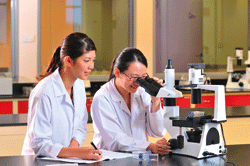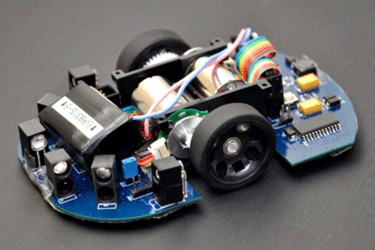by Catherine Jewell, Communications Division

NYP's incubation facilities - 15 “dry” labs
(for Engineering, ICT, IT and IDM) and 8 “wet” labs
(for Life Sciences, Materials Science and Food
Technology) - cultivate practical learning opportunities
and generate valuable industry and research insights.
(Photo: NYP-CTIC)
Over the past decade, Singapore has emerged as one of the most competitive economies in Asia, one of the easiest places in the world to do business and “a home for innovation”. Ranked third in the 2012 Global Innovation Index for the second year running, Singapore's sustained emphasis on developing its knowledge and innovation-intensive activity is paying dividends. This drive is set to continue.
In 2010, Prime Minister Lee Hsien Loong announced that Singapore will invest $16.1 billion Singapore dollars (US$12.9 billion) – a 20 percent increase over the previous five-year period – to support research, innovation and enterprise development from 2011 to 2015. “Research and innovation underpin the competitiveness of our industries, catalyze new growth and transform our economy. Increasingly, intellectual capital will be critical for our next phase of economic development,” the Prime Minister noted in a September 2010 news conference.
Research and development (R&D) has become a cornerstone of the nation's economic strategy. By 2015, the country aims to increase gross expenditure on R&D to 3.5 percent of gross domestic product (GDP). Singapore's tertiary sector – its universities, research institutes and polytechnics – play a key role in spawning the innovation that sustains its economic performance. The technology transfer offices established in each of these sectors are instrumental in moving technology from the laboratory to the market. They help identify research with commercial potential, ensure it is outcome driven, and develop strategies for its commercial exploitation.
WIPO Magazine recently interviewed Dr. Valdew Singh, Director of the Centre for Technology Innovation and Commercialisation (CTIC), the corporate arm of Nanyang Polytechnic (NYP), to find out more about CTIC's role and the challenges it faces in managing NYP's intellectual property (IP) assets. NYP has won several prestigious awards in recognition of its innovations as well as its organizational and business excellence. These include the Singapore Quality Award, the Innovation Excellence Award and the People Excellence Award. It is also an enthusiastic user of WIPO's IP services.
Established in 2008, CTIC is a relative newcomer to the field of technology transfer. However, it has quickly demonstrated how it can make a positive contribution in its role to identify, protect, manage and commercially exploit NYP's IP assets. CTIC's mission “is to serve as an effective institution-to-industry bridge to facilitate technology transfer for the greater economic good and societal benefit of Singapore. It is a conduit to support Singapore's local industry and community through NYP's inventions and innovations,” Dr. Singh explains. To this end, it helps spearhead polytechnic-wide research, foster innovation and enterprise and encourage and develop student entrepreneurship initiatives.
CTIC works closely with the Polytechnic's seven schools – Engineering, Information Technology (IT), Chemical and Life Sciences, Health Sciences, Interactive and Digital Media (IDM), Design, and Business Management – to fulfill NYP's two strategic goals: to nurture the spirit of innovation and enterprise and to “sell” its ideas. “CTIC's role and responsibilities have evolved over the years, and the Centre has now become a window to innovation and enterprise at NYP,” Dr. Singh notes.
IP protection and management

NYP researchers developed a multimedia racing
simulator to promote the Singtel F1 Grand Prix,
providing further opportunities for games innovation,
modification and production. The developed art
assets and coding of the simulator are copyright
protected and owned by NYP.
(Photo: NYP-CTIC)
The Centre focuses largely on IP portfolio management and licensing but also plays a key role in coordinating R&D funding, strengthening collaboration with other universities and research institutes, and forging links with industry and business partners.
The Centre's IP Management and Commercialization Pathway clearly and systematically defines each stage involved in taking an idea from the lab to the market. Once an invention disclosure (ID) outlining the details of an invention has been completed, it is submitted to the IP representative of the school concerned, who conducts a first-level assessment before forwarding it to CTIC. IP representatives are experts in their chosen domain and are trained by CTIC in IP management and protection.
With this multidisciplinary and close-knit team in place, CTIC can draw on a polytechnic-wide pool of expertise, leverage accumulated experience and extend its outreach and contacts. Once the ID is received, CTIC's technology officers thoroughly vet and evaluate the invention for its IP potential. A specially designed “technology & market” matrix helps to sort candidate technologies objectively and to consistently ascertain their patentability and viability from both a technology and commercial perspective. If cleared, a recommendation is made as to how to protect and commercially exploit the invention.
“The decision to file or not for IP protection depends largely on costs versus benefits,” Dr. Singh explains. “If the technology is suited only for the local market then the national phase filing of a patent for Singapore is done. However, if it has international appeal, then the Patent Cooperation Treaty (PCT) route is our preferred option. Thereafter, national phase filing for specific countries is considered in light of the commercial opportunities and interest expressed by licensees or industry partners for their specific target market(s). Provisional filing is preferred when more time is needed to gauge the interest and potential of certain technologies,” he adds.
“WIPO offers a useful and comprehensive suite of filing and registration services. Patentscope is particularly useful for doing a quick search of PCT applications filed. We use it in our due diligence before engaging patent lawyers,” he notes. “WIPO's databases are also very useful for gathering information about the IP landscape in a specific area of technology, such as clean technologies.”
On average, CTIC submits 15 patent applications each year. To date, some 188 patent applications have been filed and 137 granted. They cover inventions in fields ranging from biotechnology (life sciences, biomedical devices and systems, bioinformatics), IT and computing, engineering (electrical, electronic and mechanical as well as robotics and automation), health care and materials. CTIC handles design registrations and copyright protection for teaching and learning content, games, animation clips and software applications. It also manages the trade secrets NYP holds for its food recipes and proprietary manufacturing processes.
Licensing

A personal alarm device integrated into a mobile phone emits
a loud sound to attract attention if the owner is attacked. It also
provides a “community” feature whereby people connected within
the community receive distress signals. The invention was filed
under the PCT on October 5, 2007 (PCT/SG2007/00034).
(Photo: NYP-CTIC)
Licensing is currently the main focus of CTIC's commercialization strategy. So far, CTIC has facilitated 33 IP licensing deals, concluding, on average, around 12 such agreements a year. To ensure that the many types of licenses it handles are robust, the Centre has developed a comprehensive checklist of terms to consider when negotiating an IP license. These include the type of licensing, duration, territories, field-of-use, fees payable and mode of payment, scope of licensor's rights, prosecution and maintenance, indemnity, warranty and infringement.
In terms of negotiating licenses with technology partners from developing countries, CTIC “ensures affordability for the party concerned in return for assurances of fair use and best efforts in exploiting or applying the IP concerned. If there is a potential community benefit, we are likely to be more general with our licensing terms,” Dr. Singh explains.
CTIC's commercialization endeavor is underpinned by a desire to generate economic and social benefit. “We are not positioned as a profit maximizer but as a conduit to support local industry and the community, to make a difference in technology capability development and to improve quality of life. The revenue generated is channeled back into the polytechnic to ensure its sustained technological advancement,” Dr. Singh observes.
Enterprise development
NYP's commitment to nurturing a spirit of innovation and enterprise is also beginning to pay off in terms of spawning new start-up companies. Five such companies have so far been established by NYP staff, students and alumni in the areas of life sciences, electronics, information and communications technologies (ICTs), food technology, IDM and e-commerce. Dr. Singh sees such enterprise development as an opportunity for NYP to further boost its commercialization endeavor. CTIC's comprehensive range of “commercialization support services” plays an important role in this respect.
For example, in terms of introducing start-ups to NYP's IP portfolio for possible adoption, as well as to business mentors and funding groups. The Centre's technology and business intelligence service helps companies identify opportunities and mitigate risk, and NYP-managed incubation facilities help start-ups emerge as independent operators. Its incubation facilities, which include 15 “dry” labs (for Engineering, ICT, IT and IDM) and 8 “wet” labs (for Life Sciences, Materials Science and Food Technology) also cultivate practical learning opportunities that generate valuable industry and research insights of benefit to both start-up companies and NYP.

A local small and medium-sized enterprise (SME) specializing in robotics
licensed NYP's 2-wheel robot hardware and software developer's kit comprising
a robot and ball-tracking vision module, motion control module and PC-to-robot
communication module. The kit and its modules are copyright protected and
owned by NYP. (Photo: NYP-CTIC)
The Polytechnic “operates on a win-win premise to ensure there is a common interest and mutual benefit,” Dr. Singh explains. NYP has established a variety of domain-specific specialist technology centers, in collaboration with leading technology solution providers and partners, to spearhead the development of its technical capability in specific areas and to engage local companies to deliver customized turnkey solutions that address their proprietary needs.
“We benefit by gaining access to the latest technologies and know-how to keep ourselves up to date, and acquire a better understanding of market needs with the opportunity to engage in R&D and industry project development that offer our staff and students greater exposure,” Dr. Singh notes. “On the other hand, industry benefits from having access to expertise, facilities and resources that can enable them to enhance their products, processes and services. We also provide specific continuing education and training programs to help upgrade and improve the skill set and competencies of the industry workforce to ensure it remains relevant and current.”
Challenges
Creating a fully integrated and effective “idea-to-market” value chain is one of the key challenges facing CTIC. This involves implementing a holistic, polytechnic-wide research, innovation and enterprise strategy that aligns people, resources and technologies and is key to creating a healthy pipeline of new IP assets.
Keeping up to date with technological advances and the ever-changing business landscape as well as maintaining a lean portfolio of quality IP assets with good commercial potential are among the other challenges CTIC faces. But with challenge comes opportunity. Dr. Singh sees great scope for strengthening collaborative links with like-minded technology transfer offices, both at home and abroad. Such networks would:
- help improve market reach beyond Singapore;
- lead to opportunities for bundling IP assets to create more attractive commercial propositions;
- foster translational R&D for more relevant commercial products; and
- create opportunities to share best practices and experiences.
While strong leadership, a supportive parent organization and a healthy pipeline of promising technologies are fundamentally important, CTIC's experience offers other useful insights for those embarking on the technology transfer journey. These include the need to:

Together with the National Heart Centre, NYP researchers developed a haemostatic valve
which has been licensed to a medical and electronic device supplier that provides
solutions to the health care, diagnostics, electronics and medical device industries worldwide.
The invention was filed under the PCT on June 27, 2008 (PCT/SG2008/000232).
(Photo: NYP-CTIC)
- recruit competent, well-trained and motivated staff who are appropriately recognized and rewarded for their achievements; a team blending “new hands” with “old blood” can generate significant results, draw in fresh ideas and develop new capabilities that are carefully tempered with experience and institutional knowledge;
- adopt pragmatic and flexible policies and practices to capitalize on available resources, existing potential and capabilities; focus on improving rather than overhauling;
- offer a range of consistent, efficient and transparent innovation and business support services and develop an effective technology and business intelligence capability;
- establish and strengthen relations with industry partners, research institutes and other “connectors”, both within the organization and beyond; who knows you is as important as who you know; and
- foster a culture of innovation; keep focused on your objectives and persevere.
In its drive to remain competitive and to secure sustained economic growth, Singapore has, over the past decade, successfully transformed itself into a knowledge-based, innovation-led economy. “Research and development underpins the competitiveness of Singapore's industries and catalyzes new growth, and will hopefully continue to transform the economy,” Dr. Singh explains.
Local tertiary institutions play a major role in this, and the expertise, resources and intellectual capital they offer promise to “drive innovation, creating new opportunities in the form of new industries, new companies and new jobs,” Dr. Singh notes. Singapore's remarkable success in shaping its national innovation landscape offers useful insights into the effective development of a functional and productive innovation ecosystem that supports national economic growth. Recognized as the leading innovative polytechnic, NYP is doing its part to contribute to the continued development of Singapore's economy, industry and workforce.
